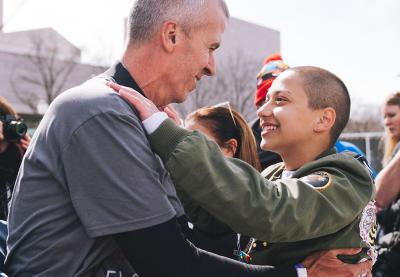After 14 children—and three school staff members—were murdered in a Florida school, their friends and classmates spoke with passionate purpose. We heard their voices amplified across the land. Like Black Lives Matter and other uprisings, these recent youth protests against gun violence are a movement born of bloodshed and passionate outrage.
But there is another catalyst for the present movement that stands out—not for its brutality or its theatrics, but for its banality. It is a spark that kindles on solitary evenings and schoolday afternoons, after grading papers or during lunch.
It is the quiet, quotidian labor of the teacher planning lessons.
Many of us watched Emma González, a senior at Marjory Stoneman Douglas High School, introduce herself to the world by waving in her hands the AP Government notes on which she’d written points for her impassioned remarks. She told us all about this class, how the students study to make sure that their “arguments based on politics and political history are watertight.” She told the world, “The students at this school have been having debates on guns for what feels like our entire lives.”
Like González, Jaclyn Corin was ready to defend her convictions with knowledge when the terrible time came. The New Yorker reported that she was “prepared to advocate for gun-law reform, having worked on a fifty-page project about gun control for her A.P. composition-and-rhetoric class a couple of months before.”
Jeff Foster is an AP Government teacher at Marjory Stoneman Douglas High School. Journalist Jorge Rivas reports that on the very day his students’ peers were killed, Foster had conducted a lesson on special interest groups, including the NRA:
His lesson plan that day included a discussion about the Columbine and Sandy Hook school shootings, with emphasis on how every politician comes out [after] a tragedy to say the right thing about changing gun regulation. The students learned how the NRA goes to work as soon [as] news reporters and the public move on to the next story.
I don’t know Jeff Foster, but I admire him.
This teacher is committed to the whole child and to the whole society in which that child is growing up. His vision and hope, writes Rivas, is that students will leave his class “and vote, run for office, or join a special interest group for an issue they care about.” He has prepared them for this and more.
In my work as a school principal, I reflect with my teacher colleagues about the activism that has been roused since the Florida shootings. As I do so, I think of the work of this teacher, the extensive research, the writing, the debates—the complex, serious, critical thinking—that he asks of students like Emma González.
In mid-March, when students at my own school broke rules to walk out of classes in an act of student-organized solidarity with victims of school violence, some teachers thought the school should have officially sanctioned the action.
My response is that if we educators wish to engage students in political action on school time, that work is about more than following students outside for a few minutes. It’s about hours designing lesson plans and carefully framing our projects to ensure that students of all identity backgrounds find a point of entry into the work. It’s about days encouraging and responding to rigorous and engaging debates and sometimes-hefty research papers that help students understand contemporary challenges and historical context.
It’s about deliberately and carefully helping them build knowledge of how public policy, laws and legislation shape their world. It’s about showing students how, in every part of our lives—from how we labor and where we live, to how we learn and who we love—we are shaped by circumstances that are shaped by policy choices past and present.
When we help our students see how power works, we help them see how they can use the tools of their own power to make their world a better place. “Legislation may not change the hearts of men,” Dr. Martin Luther King Jr. told those who gathered at Grosse Pointe High School to hear him speak in 1968, but “it does change the habits of men.” Those new habits—the things we commit to do and how we set about doing them—give new structure and meaning to our lives. They’re how we change the world.
The present moment is electric with the idealism and energy of youth. In March, a dozen students I admire here in Vermont took a train to D.C. and then took to the streets, marching behind the banner of Emma González and hundreds of other young people: their outrage, their eloquence and their policy demands. In the quieter moments that follow the march, let the educators who admire González and her peers remember that the first flag she waved at the world, tears in her eyes and precision in her demands, was the stack of notes she wrote in history class.
Hawkes is a co-principal at Randolph Union Middle/High School in Randolph, Vermont. You can follow him on Twitter @ElijahHawkes.
